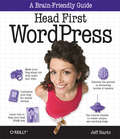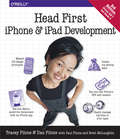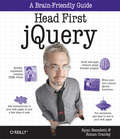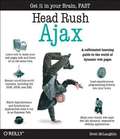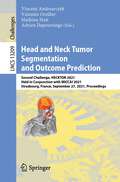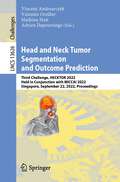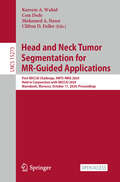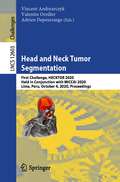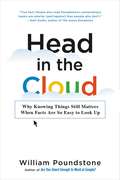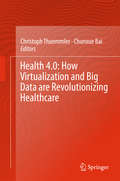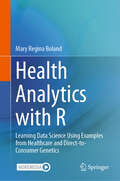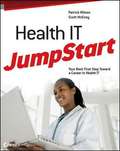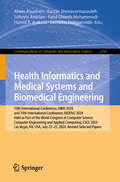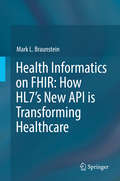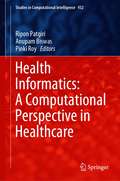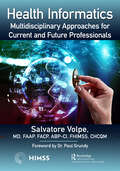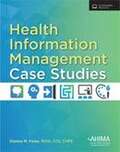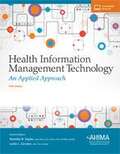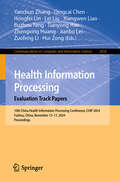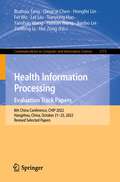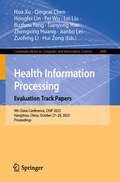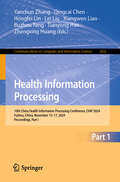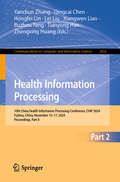- Table View
- List View
Head First WordPress
by Jeff SiartoAuthor Siarto, an experienced WordPress user and web designer, unlocks the mysteries of the WordPress platform in this well-illustrated reference. The author uses a conversational and frequently humorous approach to demonstrate how to customize blogs with URLs and templates, how to embed video and audio, support several authors, set up podcasts, cache pages for a faster website, avoid hackers, and manage websites with WordPress. Annotation ©2011 Book News, Inc. , Portland, OR (booknews. com)
Head First WordPress: A Brain-Friendly Guide to Creating Your Own Custom WordPress Blog
by Jeff SiartoWhether you’re promoting your business or writing about your travel adventures, Head First WordPress will teach you not only how to make your blog look unique and attention-grabbing, but also how to dig into the more complex features of WordPress 3.0 to make your website work well, too.You’ll learn how to move beyond the standard WordPress look and feel by customizing your blog with your own URL, templates, plugin functionality, and more. As you learn, you’ll be working with real WordPress files: The book’s website provides pre-fab WordPress themes to download and work with as you follow along with the text.Gain immediate experience with WordPress 3.0, the June 2010 release of the softwareGet your site up and running by setting up a MySQL database and creating configuration filesWork with the Wordpress platform to create posts and pages, learn the difference between tags and categories, edit content, moderate comments, and manage spamExplore how to extend Wordpress with plugins and templatesConvert custom designs (in HTML and CSS) into functional themes and use them in WordPressWe think your time is too valuable to waste struggling with new concepts. Using the latest research in cognitive science and learning theory to craft a multi-sensory learning experience, Head First WordPress uses a visually rich format designed for the way your brain works, not a text-heavy approach that puts you to sleep.
Head First iPhone and iPad Development: A Learner's Guide to Creating Objective-C Applications for the iPhone and iPad (Oreilly And Associate Ser.)
by Dan Pilone Tracey PiloneHave a killer app idea for iPhone and iPad? Head First iPhone and iPad Development will help you get your first application up and running in no time. You'll not only learn how to design for Apple's devices, you'll also master the iPhone SDK tools -- including Interface Builder, Xcode, and Objective-C programming principles -- to create eye-catching, top-selling apps.
Head First jQuery: A Brain-Friendly Guide
by Ronan Cranley Ryan BenedettiWant to add more interactivity and polish to your websites? Discover how jQuery can help you build complex scripting functionality in just a few lines of code. With Head First jQuery, you'll quickly get up to speed on this amazing JavaScript library by learning how to navigate HTML documents while handling events, effects, callbacks, and animations. By the time you've completed the book, you'll be incorporating Ajax apps, working seamlessly with HTML and CSS, and handling data with PHP, MySQL and JSON.If you want to learn—and understand—how to create interactive web pages, unobtrusive script, and cool animations that don't kill your browser, this book is for you.Use jQuery with DOM to overcome the limitations of HTML and CSSLearn how jQuery selectors and actions work togetherWrite functions and wire them to interface elementsUse jQuery effects to create actions on the pageMake your pages come alive with animationBuild interactive web pages with jQuery and AjaxBuild forms in web applications
Head Rush Ajax
by Brett MclaughlinSick of creating web sites that reload every time a user moves the mouse? Tired of servers that wait around to respond to users' requests for movie tickets? It sounds like you need a little (or maybe a lot of) Ajax in your life. Asynchronous programming lets you turn your own websites into smooth, slick, responsive applications that make your users feel like they're back on the information superhighway, not stuck on a dial-up backroad. But who wants to take on next-generation web programming with the last generation's instruction book? You need a learning experience that's as compelling and cutting-edge as the sites you want to design. That's where we come in. With Head Rush Ajax , in no time you'll be writing JavaScript code that fires off asynchronous requests to web servers...and having fun doing it. By the time you've taken your dynamic HTML, XML, JSON, and DOM skills up a few notches, you'll have solved tons of puzzles, figured out how well snowboards sell in Vail, and even watched a boxing match. Sound interesting? Then what are you waiting for? Pick up Head Rush Ajax and learn Ajax and asynchronous programming the right way--the way that sticks. If you've ever read a Head First book, you know what to expect: a visually rich format designed for the way your brain works. Head Rush ramps up the intensity with an even faster look and feel. Have your first working app before you finish Chapter 1, meet up with the nefarious PROJECT: CHAOS stealth team, and even settle the question of the Top 5 Blues CDs of all time. Leave boring, clunky websites behind with 8-tracks and hot pants--and get going with next-generation web programming. "If you thought Ajax was rocket science, this book is for you. Head Rush Ajax puts dynamic, compelling experiences within reach for every web developer." -- Jesse James Garrett, Adaptive Path "A 'technology-meets-reality' book for web pioneers on the cutting edge." -- Valentin Crettaz, CTO, Condris Technologies
Head and Neck Tumor Segmentation and Outcome Prediction: Second Challenge, HECKTOR 2021, Held in Conjunction with MICCAI 2021, Strasbourg, France, September 27, 2021, Proceedings (Lecture Notes in Computer Science #13209)
by Vincent Andrearczyk Valentin Oreiller Adrien Depeursinge Mathieu HattThis book constitutes the Second 3D Head and Neck Tumor Segmentation in PET/CT Challenge, HECKTOR 2021, which was held in conjunction with the 24th International Conference on Medical Image Computing and Computer-Assisted Intervention, MICCAI 2021. The challenge took place virtually on September 27, 2021, due to the COVID-19 pandemic.The 29 contributions presented, as well as an overview paper, were carefully reviewed and selected form numerous submissions. This challenge aims to evaluate and compare the current state-of-the-art methods for automatic head and neck tumor segmentation. In the context of this challenge, a dataset of 325 delineated PET/CT images was made available for training.
Head and Neck Tumor Segmentation and Outcome Prediction: Third Challenge, HECKTOR 2022, Held in Conjunction with MICCAI 2022, Singapore, September 22, 2022, Proceedings (Lecture Notes in Computer Science #13626)
by Vincent Andrearczyk Valentin Oreiller Adrien Depeursinge Mathieu HattThis book constitutes the Third 3D Head and Neck Tumor Segmentation in PET/CT Challenge, HECKTOR 2022, which was held in conjunction with the 25th International Conference on Medical Image Computing and Computer-Assisted Intervention, MICCAI 2022, on September 22, 2022.The 22 contributions presented, as well as an overview paper, were carefully reviewed and selected from 24 submissions. This challenge aims to evaluate and compare the current state-of-the-art methods for automatic head and neck tumor segmentation. In the context of this challenge, a dataset of 883 delineated PET/CT images was made available for training.
Head and Neck Tumor Segmentation for MR-Guided Applications: First MICCAI Challenge, HNTS-MRG 2024, Held in Conjunction with MICCAI 2024, Marrakesh, Morocco, October 17, 2024, Proceedings (Lecture Notes in Computer Science #15273)
by Kareem A. Wahid Cem Dede Mohamed A. Naser Clifton D. FullerThis Open Access book constitutes the refereed proceedings of the First MICCAI Challenge, HNTSMRG 2024, Held in Conjunction with MICCAI 2024, in Marrakesh, Morocco, on October 17, 2024. The 20 full papers and 1 overview paper included in this volume were carefully reviewed and selected from a total of 21 submissions. The HNTS-MRG 2024 Challenge focuses on advancing clinical workflows by leveraging artificial intelligence (AI) for automated segmentation of tumor regions in multi-timepoint MRI scans.
Head and Neck Tumor Segmentation: First Challenge, HECKTOR 2020, Held in Conjunction with MICCAI 2020, Lima, Peru, October 4, 2020, Proceedings (Lecture Notes in Computer Science #12603)
by Vincent Andrearczyk Valentin Oreiller Adrien DepeursingeThis book constitutes the First 3D Head and Neck Tumor Segmentation in PET/CT Challenge, HECKTOR 2020, which was held in conjunction with the 23rd International Conference on Medical Image Computing and Computer-Assisted Intervention, MICCAI 2020, in Lima, Peru, in October 2020. The challenge took place virtually due to the COVID-19 pandemic.The 2 full and 8 short papers presented together with an overview paper in this volume were carefully reviewed and selected form numerous submissions. This challenge aims to evaluate and compare the current state-of-the-art methods for automatic head and neck tumor segmentation. In the context of this challenge, a dataset of 204 delineated PET/CT images was made available for training as well as 53 PET/CT images for testing. Various deep learning methods were developed by the participants with excellent results.
Head in the Cloud: Why Knowing Things Still Matters When Facts Are So Easy to Look Up
by William PoundstoneThe real-world value of knowledge in the mobile-device age.More people know who Khloe Kardashian is than who Rene Descartes was. Most can't find Delaware on a map, correctly spell the word occurrence, or name the largest ocean on the planet. But how important is it to fill our heads with facts? A few keystrokes can summon almost any information in seconds. Why should we bother learning facts at all?Bestselling author William Poundstone confronts that timely question in HEAD IN THE CLOUD. He shows that many areas of knowledge correlate with the quality of our lives--wealth, health, and happiness--and even with politics and behavior. Combining Big Data survey techniques with eye-opening anecdotes, Poundstone examines what Americans know (and don't know) on topics ranging from quantum physics to pop culture. HEAD IN THE CLOUD asks why we're okay with spelling errors on menus but not on resumes; why Fox News viewers don't know which party controls Congress; why people who know "trivia" make more money than those who don't; how individuals can navigate clickbait and media spin to stay informed about what really matters. Hilarious, humbling, and wildly entertaining, HEAD IN THE CLOUD is a must-read for anyone who doesn't know everything.
Health 4.0: How Virtualization and Big Data are Revolutionizing Healthcare
by Christoph Thuemmler Chunxue BaiThis book describes how the creation of new digital services--through vertical and horizontal integration of data coming from sensors on top of existing legacy systems--that has already had a major impact on industry is now extending to healthcare. The book describes the fourth industrial revolution (i. e. Health 4. 0), which is based on virtualization and service aggregation. It shows how sensors, embedded systems, and cyber-physical systems are fundamentally changing the way industrial processes work, their business models, and how we consume, while also affecting the health and care domains. Chapters describe the technology behind the shift of point of care to point of need and away from hospitals and institutions; how care will be delivered virtually outside hospitals; that services will be tailored to individuals rather than being designed as statistical averages; that data analytics will be used to help patients to manage their chronic conditions with help of smart devices; and that pharmaceuticals will be interactive to help prevent adverse reactions. The topics presented will have an impact on a variety of healthcare stakeholders in a continuously global and hyper-connected world. #65533; Presents explanations of emerging topics as they relate to e-health, such as Industry 4. 0, Precision Medicine, Mobile Health, 5G, Big Data, and Cyber-physical systems; #65533; Provides overviews of technologies in addition to possible application scenarios and market conditions; #65533; Features comprehensive demographic and statistic coverage of Health 4. 0 presented in a graphical manner.
Health Analytics with R: Learning Data Science Using Examples from Healthcare and Direct-to-Consumer Genetics
by Mary Regina BolandThis textbook teaches health analytics using examples from the statistical programming language R. It utilizes real-world examples with publicly available datasets from healthcare and direct-to-consumer genetics to provide learners with real-world examples and enable them to get their hands on actual data. This textbook is designed to accompany either a senior-level undergraduate course or a Masters level graduate course on health analytics. The reader will advance from no prior knowledge of R to being well versed in applications within R that apply to data science and health analytics. “I have never seen a book like this and think it will make an important contribution to the field. I really like that it covers environmental, social, and geospatial data. I also really like the coverage of ethics. These aspects of health analytics are often overlooked or deemphasized. I will definitely buy copies for my team.” - Jason Moore, Cedars-Sinai Medical Center “Overall, I have a highly positive impression of the book. It is VERY comprehensive. It covers very extensive data types. I do not recall other books with the same level of comprehensiveness.” - Shuangge Ma, Yale University “The book is comprehensive in both aspects of genetics, and health analytics. It covers any type of information a healthcare data scientist should be familiar with, whether they are novice or experienced. I found any chapter that I looked into comprehensive, but also not too detailed (although in general this book is more than 600 pages of comprehensive and detailed relevant information).” - Robert Moskovtich, Ben-Gurion University of the Negev
Health IT JumpStart
by Patrick Wilson Scott McevoyIT professionals can learn how to launch a career in health information technology Government regulation is mandating that all physician practices, hospitals, labs, etc. move to electronic health records (EHR) by 2014, which, in turn, will create a demand for IT professionals to help medical facilities make this transition as smooth as possible. This book helps IT professionals make the move into health information technology (HIT) and shows you how EHRs can be securely created, maintained, distributed, and backed up under government regulations. The author duo is a pair of HIT experts who understand how medical data works and willingly share their expertise with you so that you can best serve this emerging, evolving market. You'll quickly benefit from using this book as your first step to understanding and preparing for a job in HIT. Opens the door to researching how to make the move from IT to the up-and-coming field of health information technology (HIT) Guides you through the four aspects of HIT: government regulation and funding, operational workflow, clinical understanding, and the technology that ties it all together Prepares you for the healthcare market with a roadmap of understandable advice that escorts you through complex government information Pares down the extraneous material and delivers the need-to-know information on securely maintaining electronic health records Jump into the up-and-coming world of health IT with this helpful and insightful book.
Health IT and Patient Safety: Building Safer Systems for Better Care
by Committee on Patient Safety Health Information TechnologyIOM's 1999 landmark study To Err is Human estimated that between 44,000 and 98,000 lives are lost every year due to medical errors. This call to action has led to a number of efforts to reduce errors and provide safe and effective health care. Information technology (IT) has been identified as a way to enhance the safety and effectiveness of care. In an effort to catalyze its implementation, the U. S. government has invested billions of dollars toward the development and meaningful use of effective health IT. Designed and properly applied, health IT can be a positive transformative force for delivering safe health care, particularly with computerized prescribing and medication safety. However, if it is designed and applied inappropriately, health IT can add an additional layer of complexity to the already complex delivery of health care. Poorly designed IT can introduce risks that may lead to unsafe conditions, serious injury, or even death. Poor human-computer interactions could result in wrong dosing decisions and wrong diagnoses. Safe implementation of health IT is a complex, dynamic process that requires a shared responsibility between vendors and health care organizations. Health IT and Patient Safety makes recommendations for developing a framework for patient safety and health IT. This book focuses on finding ways to mitigate the risks of health IT-assisted care and identifies areas of concern so that the nation is in a better position to realize the potential benefits of health IT. Health IT and Patient Safety is both comprehensive and specific in terms of recommended options and opportunities for public and private interventions that may improve the safety of care that incorporates the use of health IT. This book will be of interest to the health IT industry, the federal government, healthcare providers and other users of health IT, and patient advocacy groups.
Health Informatics and Medical Systems and Biomedical Engineering: 10th International Conference, HIMS 2024, and 10th International Conference, BIOENG 2024, Held as Part of the World Congress in Computer Science, Computer Engineering and Applied Computing, CSCE 2024, Las Vegas, NV, USA, July 22–25, 2024, Revised Selected Papers (Communications in Computer and Information Science #2259)
by Hamid R. Arabnia Leonidas Deligiannidis Abeer Alsadoon Soheyla Amirian Farzan Shenavarmasouleh Farid Ghareh MohammadiThis book constitutes the proceedings of the 10th International Conference on Health Informatics and Medical Systems and the 10th International Conference on Biomedical Engineering, BIOENG 2024, held as part of the 2024 World Congress in Computer Science, Computer Engineering and Applied Computing, in Las Vegas, USA, during July 22 to July 25, 2024. The 31 HIMS 2024 papers included were carefully reviewed and selected from 141 submissions. BIOENG 2024 received 78 submissions and accepted 13 papers for inclusion in the proceedings. The papers have been organized in topical sections as follows: Biomedical engineering; algorithms, applications and methodologies; health informatics and medical systems; and algorithms, applications and methodologies.
Health Informatics on FHIR: How HL7's New API is Transforming Healthcare
by Mark L. BraunsteinThis textbook begins with an introduction to the US healthcare delivery system, its many systemic challenges and the prior efforts to develop and deploy informatics tools to help overcome those problems. It goes on to discuss health informatics from an historical perspective, its current state and its likely future state now that electronic health record systems are widely deployed, the HL7 Fast Healthcare Interoperability standard is being rapidly accepted as the means to access the data stored in those systems and analytics is increasing being used to gain new knowledge from that aggregated clinical data. It then turns to some of the important and evolving areas of informatics including population and public health, mHealth and big data and analytics. Use cases and case studies are used in all of these discussions to help readers connect the technologies to real world challenges. Effective use of informatics systems and tools by providers and their patients is key to improving the quality, safety and cost of healthcare. With health records now digital, no effective means has existed for sharing them with patients, among the multiple providers who may care for them and for important secondary uses such as public/population health and research. This problem is a topic of congressional discussion and is addressed by the 21st Century Cures Act of 2016 that mandates that electronic health record (EHR) systems offer a patient-facing API. HL7’s Fast Healthcare Interoperability Resources (FHIR) is that API and this is the first comprehensive treatment of the technology and the many ways it is already being used. FHIR is based on web technologies and is thus a far more facile, easy to implement approach that is rapidly gaining acceptance. It is also the basis for a ‘universal health app platform’ that literally has the potential to foster innovation around the data in patient records similar to the app ecosystems smartphones created around the data they store. FHIR app stores have already been opened by Epic and Cerner, the two largest enterprise EHR vendors. Provider facing apps are already being explored to improve EHR usability and support personalized medicine. Medicare and the Veteran’s Administration have announced FHIR app platforms for their patients. Apple’s new IOS 11.3 features the ability for consumers to aggregate their health records on their iPhone using FHIR. Health insurance companies are exploring applications of FHIR to improve service and communication with their providers and patients. SureScripts, the national e-Prescribing network, is using FHIR to help doctors know if their patients are complying with prescriptions. This textbook is for introductory health informatics courses for computer science and health sciences students (e.g. doctors, nurses, PhDs), the current health informatics community, IT professionals interested in learning about the field and practicing healthcare providers. Though this textbook covers an important new technology, it is accessible to non-technical readers including healthcare providers, their patients or anyone interested in the use of healthcare data for improved care, public/population health or research.
Health Informatics: A Computational Perspective in Healthcare (Studies in Computational Intelligence #932)
by Ripon Patgiri Anupam Biswas Pinki RoyThis book presents innovative research works to demonstrate the potential and the advancements of computing approaches to utilize healthcare centric and medical datasets in solving complex healthcare problems. Computing technique is one of the key technologies that are being currently used to perform medical diagnostics in the healthcare domain, thanks to the abundance of medical data being generated and collected. Nowadays, medical data is available in many different forms like MRI images, CT scan images, EHR data, test reports, histopathological data and doctor patient conversation data. This opens up huge opportunities for the application of computing techniques, to derive data-driven models that can be of very high utility, in terms of providing effective treatment to patients. Moreover, machine learning algorithms can uncover hidden patterns and relationships present in medical datasets, which are too complex to uncover, if a data-driven approach is not taken. With the help of computing systems, today, it is possible for researchers to predict an accurate medical diagnosis for new patients, using models built from previous patient data. Apart from automatic diagnostic tasks, computing techniques have also been applied in the process of drug discovery, by which a lot of time and money can be saved. Utilization of genomic data using various computing techniques is another emerging area, which may in fact be the key to fulfilling the dream of personalized medications. Medical prognostics is another area in which machine learning has shown great promise recently, where automatic prognostic models are being built that can predict the progress of the disease, as well as can suggest the potential treatment paths to get ahead of the disease progression.
Health Informatics: Multidisciplinary Approaches for Current and Future Professionals (HIMSS Book Series)
by Salvatore Volpe"True wellness innovation requires the recruitment of multi-disciplinary participants. This book breaks the mold with examples from healthcare experts and other professionals who have leveraged informatics to better the lives of their constituents." — Jason Helgerson, Founder & CEO, Helgerson Solutions Group LLC Developed for those training in academic centers as well as for those already "out in the field," this book looks at how attorneys, behavioral health experts, business development experts, chief information officers, chief medical officers, chief nursing information officers, consumer advocates, cryptographic experts, futurists, geneticists, informaticists, managed care executives, nurses, pharmacists, physicians, public health professionals, software developers, systems security officers, and workforce experts are collaborating on a "team-based," IT-enabled approach to improve healthcare.
Health Information Management Case Studies
by Dianna M. FoleyThe contents of the Health Information Management Case Studies include: Domain I Data Content, Structure, and Standards (Information Governance); Domain II Information Protection: Access, Disclosure, Archival, Privacy and Security; Domain III--Informatics, Analytics, and Data Use; Domain IV--Revenue Management;Domain V--Compliance; and Domain VI--Leadership.
Health Information Management Technology An Applied Approach 5th Edition
by Leslie L. Gordon Nanette B. SaylesCreates a blueprint for success in the health information management (HIM) field. Chapter content is expanded in the fifth edition to prepare students for transitional and changing roles in an electronic health information environment. All chapters are updated to reflect current HIM trends, practices, standards, and legal issues. Written by distinguished leaders in the field, this book guides students through two-year academic programs in preparation for the Registered Health Information Technician (RHIT) certification exam and beyond
Health Information Processing. Evaluation Track Papers: 10th China Health Information Processing Conference, CHIP 2024, Fuzhou, China, November 15–17, 2024, Proceedings (Communications in Computer and Information Science #2458)
by Lei Liu Yanchun Zhang Hongfei Lin Tianyong Hao Xiangwen Liao Buzhou Tang Qingcai Chen Jianbo Lei Zuofeng Li Hui Zong Zhengxing HuangThis book constitutes the refereed proceedings of the 10th China Health Information Processing Conference, CHIP 2024, held in Fuzhou, China, November 15–17, 2024.The CHIP 2024 Evaluation Track proceedings include 19 full papers which were carefully reviewed and grouped into these topical sections: syndrome differentiation thought in Traditional Chinese Medicine; lymphoma information extraction and automatic coding; and typical case diagnosis consistency.
Health Information Processing. Evaluation Track Papers: 8th China Conference, CHIP 2022, Hangzhou, China, October 21–23, 2022, Revised Selected Papers (Communications in Computer and Information Science #1773)
by Lei Liu Fei Wu Hongfei Lin Tianyong Hao Buzhou Tang Qingcai Chen Yanshan Wang Haitian Wang Jianbo Lei Zuofeng Li Hui ZongThis book constitutes the papers presented at the Evaluation Track of the 8th China Conference on Health Information Processing, CHIP 2022, held in Hangzhou, China during October 21–23, 2022.The 20 full papers included in this book were carefully reviewed and selected from 20 submissions. They were organized in topical sections as follows: text mining for gene-disease association semantic; medical causal entity and relation extraction; medical decision tree extraction from unstructured text; OCR of electronic medical document; clinical diagnostic coding.
Health Information Processing. Evaluation Track Papers: 9th China Conference, CHIP 2023, Hangzhou, China, October 27–29, 2023, Proceedings (Communications in Computer and Information Science #2080)
by Lei Liu Fei Wu Hongfei Lin Tianyong Hao Buzhou Tang Qingcai Chen Jianbo Lei Zuofeng Li Hui Zong Hua Xu Zhengxing HuangThis book constitutes the refereed proceedings of the evaluation track of the 9th China Health Information Processing Conference, CHIP 2023, held in Hangzhou, China, during October 27–29, 2023. The 15 algorithms papers and 6 overview papers included in this book were carefully reviewed and selected from a total of 66 submissions to the conference. They were organized in topical sections as follows: CHIP-PromptCBLUE Medical Large Model Evaluation; Chinese Medical Text Few-shot Named Entity Recognition; Drug Paper Document Recognition and Entity Relation Extraction; CHIP-YIER Medical Large Model Evaluation; Medical Literature PICOS Identification; Chinese Diabetes Question Classification;
Health Information Processing: 10th China Health Information Processing Conference, CHIP 2024, Fuzhou, China, November 15–17, 2024, Proceedings, Part I (Communications in Computer and Information Science #2432)
by Lei Liu Yanchun Zhang Hongfei Lin Tianyong Hao Xiangwen Liao Buzhou Tang Qingcai Chen Zhengxing HuangThis two-volume set CCIS 2432-2433 constitutes the refereed proceedings of the 10th China Health Information Processing Conference, CHIP 2024, held in Fuzhou, China, during November 15–17, 2024. The 32 full papers included in this set were carefully reviewed and selected from 65 submissions. They are organized in topical sections as follows: biomedical data processing and model application; mental health and disease prediction; and drug prediction and knowledge map.
Health Information Processing: 10th China Health Information Processing Conference, CHIP 2024, Fuzhou, China, November 15–17, 2024, Proceedings, Part II (Communications in Computer and Information Science #2433)
by Lei Liu Yanchun Zhang Hongfei Lin Tianyong Hao Xiangwen Liao Buzhou Tang Qingcai Chen Zhengxing HuangThis two-volume set CCIS 2432-2433 constitutes the refereed proceedings of the 10th China Health Information Processing Conference, CHIP 2024, held in Fuzhou, China, during November 15–17, 2024. The 32 full papers included in this set were carefully reviewed and selected from 65 submissions. They are organized in topical sections as follows: biomedical data processing and model application; mental health and disease prediction; and drug prediction and knowledge map.
